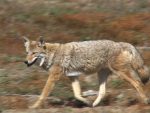Local Coyote Expert Speaks on How to Limit Interactions With Coyotes
By Susie Dummit

With coyote sighting seemingly on the rise, many Westchester residents are rightfully worried about the threat that they pose.
Last Wednesday, Carol Henger of Fordham University, who studies and tracks New York City’s urban and suburban coyotes, spoke at the Katonah Village Library about the rising existence of urban and suburban coyotes and how to deal with them.
Henger addressed the audience’s greatest concern: human-coyote interactions. Coyotes will often hunt house cats and other small animals, since they view them as prey.
“We should promote coexistence,” said Henger, who works with the Gotham Coyote Project at the Louis Calder Center in Armonk. “They’re here to stay, so it all depends on how we interact with them.”
Coyotes will often attack dogs in a competitive manner and act as predators toward smaller dogs, she said. Even attacks on small children are possible, although rare, such as the Apr. 30 encounter when a rabid coyote injured a five-year-old child at a park in Thornwood.
She recommended that pet owners keep their cats indoors, dogs should be kept on leashes and small children should be closely monitored.
“Yes, you should be watching children and small dogs when coyotes are in the area,” Henger remarked. “But you should probably be watching them anyway.”
A key factor behind the population growth of coyotes in urban and suburban areas is that parks and backyards are perfect environments for them. With plenty of open green spaces, shelter providing good cover and a variety of food sources such as compost bins, bird feeders and even small pets and other animals, sightings are increasingly common, she said.
However, coyotes are not much of a threat if precautions are taken. According to data from the Gotham Coyote Project, only about 40 coyote attacks are reported across the U.S. annually, and few are fatal, Henger said. Of wild animals that are tested in the New York area, coyotes have been the second least likely to have rabies behind deer, she said.
If someone finds themselves being confronted by a coyote, Henger said stand tall and speak in a loud, clear voice to assert your dominance and make sure you’re not viewed as weak.
To prevent coyotes from invading residents’ property, she urged local residents to remove all food sources by never leaving pet food or extra compost outside or trash or bird feed that could serve as a snack, Henger said. Coyotes are able to adapt their eating habits based on the environment, even if that means eating human food or bird seed, she said.
Installing a fence at least six feet high with rollers on top to prevent coyotes from climbing over is also recommended.
To guard against comfortable places to hide, vegetation that coyotes could use as cover should be trimmed. Wire fencing should be placed under porches and sheds to prevent them from sheltering near people.
Henger said coyotes play an important role in local ecosystems, controlling the populations of small mammals and pests such as rodents, rabbits and deer and increasing bird diversity by hunting their predators.

Examiner Media – Keeping you informed with professionally-reported local news, features, and sports coverage.
